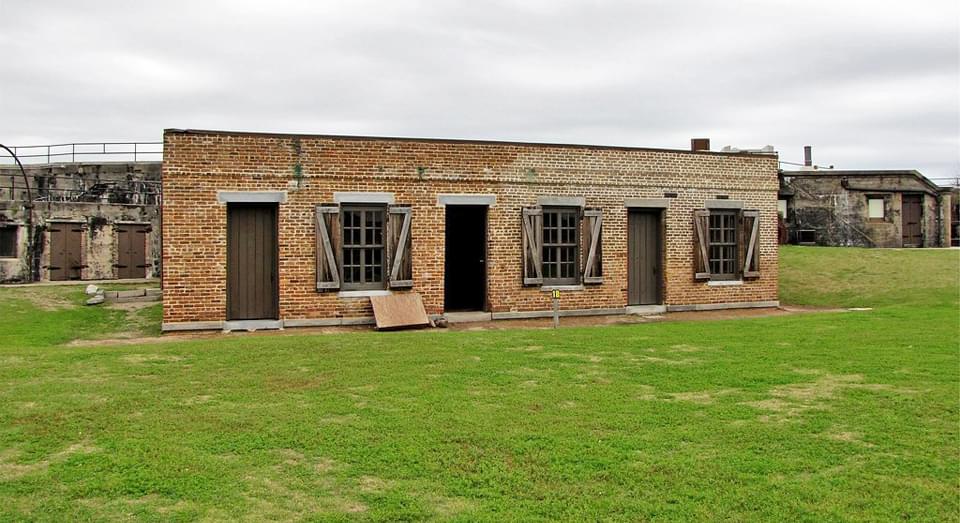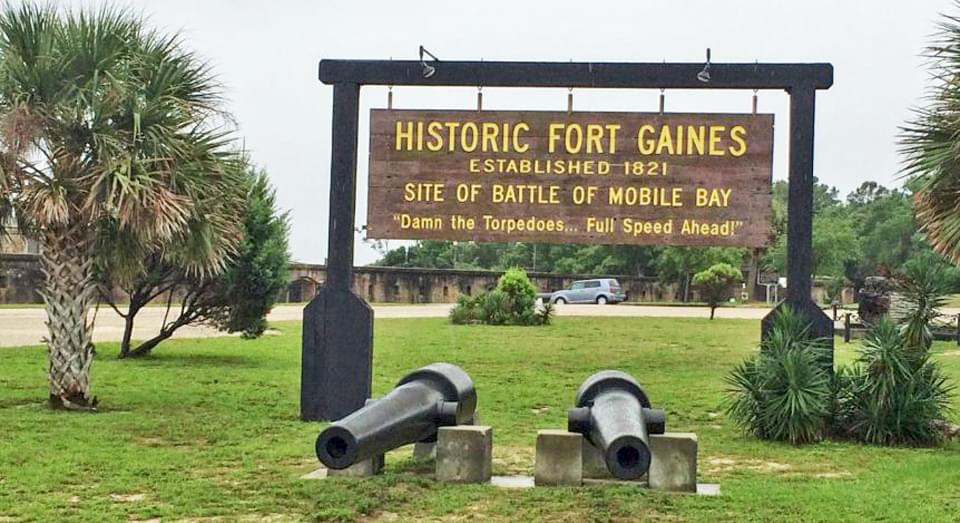Dauphin Island Alabama
Fort Gaines
Entities still are on duty and behave accordingly.

DESCRIPTION/HISTORY
Because of the need for a southern coastal defense, brought to light by the war of 1812, Congress decided that the United States needed a fort or two along the southern coast, to be part of a comprehensive system of national defense. One logical location was Dauphin Island, which had been in the past a sought after strategic site by various military forces; France, who first established a small colony there as well, Spain, and Great Britain, who had used it as a platform to attack the city of Mobile during 1812 War. With the best intentions, in 1821, the wheels were started to construct a fort which was supposed to be finished in 1858.
However, the government didn’t hire the most experienced people to build this fort, and they turned out to be not the brightest bulbs in the pack. Engineers on this project built the fort so close to Mobile Bay, that the water entered the structure at high tide. OOPS! The contractors also needed another course in money management, as they overspent their budget, leaving a shambled mess of a fort, in need of more money to pay for more massive construction.
The Army doggedly tried to renew money allotments to build Fort Gaines, and finally in 1845, Congress gave another $20,000, but other problems popped up, like a fight over land rights. Finally, the Army was given a clear deed to the Dauphin Island site in 1853. The chief engineer assigned to this task was a skilled, bright, military-savvy man, Joseph G. Totten. Joseph took one look at the original plans, which by this time were outdated and not very good in the first place, and decided to begin anew.
Totten designed a completely new fort, a city within itself, which featured the most up-to-date military architecture. The 22.5 foot tall walls, which were 4.5 ft. thick at the top, were built of brick and sand construction, which gave them the ability to absorb any artillery fire. Totten hired brick craftsmen who really knew their craft, as today the rock solid gorge bastions are showcases of intricate masonry, all without keystones. The northwest bastion is preserved in its original condition.
To seriously hamper enemy ships from attacking the fort from western Mobile Bay on the fort’s vulnerable land side, Totten built a dry moat, crossed by a drawbridge, which extends outward about 35 feet from the fort’s wall base. Fort Gaines had plenty of firepower for the time installed. Each of the five walls sported 10 top-mounted guns, while each bastion held four flank howitzers. There were cannon ports places in the side walls, and the entire roof of each bastion had catch basins for rain water, which was strained through a bed of shells and sand, winding up in large storage cisterns beneath the fort’s floor and in the yard, providing a water supply in times of siege.
All of the bastions are connected to the main courtyard via large tunnels, making everything accessible to personnel. About 500 feet from the entrance, an assortment of buildings were built to provide services and shelter for troops stationed there.
In 1858, the fort, nearing completion, was named after a War of 1812/Indian Wars military hero and skilled leader, General Edmund Pendleton Gaines, who had passed away in 1849. By 1861, most of the work on Fort Gaines was done. The rest of the finishing touches were supplied by the Confederate States of America.
Fort Gaines became an important military asset to the Confederacy during the Civil War. It was the center of operations for Confederate blockade-running efforts, which led to the important Battle of Mobile Bay in August 2-23, 1864. Union commanders Adm. David G. Farragut and Maj. Gen. Gordon Granger came with 14 wooden ships and 4 monitors, and in coordination with Union land army forces near Mobile took on the awesome task of shutting down these blockade-running efforts, which they did.
The guns on the fort walls along with the ship mines in Mobile Bay caused damage and death to the Union fleet. Adm. David G. Farragut shouted the order to ignore the risks, with his now famous quote: “Damn the torpedoes! Full steam ahead!”
Once the ships got by the gun power of Fort Gaines, the Union fleet defeated the modest Confederate fleet, and the occupiers surrendered soon after, avoiding a bloody hand-to-hand encounter. Combined casualties only totaled 1,822 – a small number compared to other battles.
Despite being sold to the City of Mobile in 1926, becoming the property of the State of Alabama, Fort Gaines has a long history of military service, and modifications were done to make it up-to-date.
In 1898, for the Spanish-American War, three six-inch disappearing naval guns and three rapid fire three inch naval guns were added to the eastern walls, eliminating the need for the corner bastions.
During World War I, a coastal artillery unit garrison was on duty, manning the disappearing guns, becoming an anti-aircraft gunnery school, even after the War ended.
During World War 2, Fort Gaines was used as a camp site for both the Alabama National Guard and as a base of the U.S. Coast Guard who went after prowling enemy submarines, looking for merchant vessels in the Gulf of Mexico.
Even today, the Coast Guard still has a base here, and uses it when they take part in crash rescue boat incidents.
HISTORY OF MANIFESTATIONS
The fort has seen a lot of action throughout the years. It stands to reason that men died here on their tours of duty, in peace-time accidents or in battle.
Or perhaps they died attacking the Fort itself. Either the entities which now observe the living don’t know they are dead, or they continue serving because they weren’t ready to move on to the other side, feeling perhaps they still had duties to perform. Ghosts have been described as what is left of people with dysfunctional personalities, fixated on the past and not able to go forward.

MANIFESTATIONS
For sure, we know that in the Battle of Mobile Bay, there were a total of 1,822 combined Union-Confederate deaths from sea and land battles.
Activity Heard and Felt
Phantom foot steps have been heard all over the areas of the Historical Fort Gaines. Cold spots have probably been felt as well.
Spirits of Soldiers
Apparitions of soldiers described as spooky figures have been observed by the living; tourists and Park employees as well, all over the Fort.
Spirit of the Vigilant Soldier
People who leave the Fort are sometimes followed by apparitions, checking up on them, which disappear after the living leave the front gates.
PSYCHIC RESEARCH
Ghoststudies.com work as Paranormal Investigators who, as a side job, look for extremely haunted places for MTV’s FEAR series. Fort Gaines has been put on their list. Investigating for MTV gives the team the advantage of going to areas not normally opened to the public, and spending time there. Check out the pictures taken, some of which show shadowy figures.
Sapi, which is a paranormal research group based in Mobile, Alabama, holds its annual Ghost Hunt at Fort Gaines, to give novice ghost hunters the thrill of hunting ghosts using real equipment, and the opportunity to be educated through lectures on basic ghost hunting techniques.

STILL HAUNTED?
Yes indeed!
Many entities call the Fort Gaines home, and go about their business at hand, keeping an eye on both living civilians and the enemy which probably ended their lives.

LOCATION
51 Bienville Boulevard
Dauphin Island, Alabama 36528
(251) 861-6992
Fort Gaines can be found in a strategic spot on Dauphin Island, part of the Dauphin Island Park, maintained by the Dauphin Island Park and Beach Board, funded by the Alabama Department of Conservation. Fort Gaines is just south of Mobile, and has a glorious view of Mobile Bay and the Gulf of Mexico. Parts of the Fort are open to the pubic via a paid tour.
Exit at I-10 at 193 South to Dauphin Island. Turn left at large water tower on island.

SOURCES INCLUDE
- theshadowlands.net
- cr.nps.gov
- dauphinisland.org
Our Haunted Paranormal Stories are Written by Julie Carr
Our Photos by Tom Carr unless otherwise credited in sources
Your Paranormal Road Trip
VIDEOS TO VISIT …










































































































































